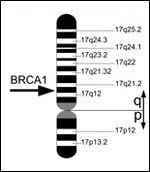Triple-Negative Breast Cancer Characterized in Younger Breast Cancer Patients
A study published online in the Journal of Clinical Oncology analyzed triple-negative breast cancer (TNBC) for distinguishing characteristics. The study compared clinical, pathological, and hormone-related lifestyle characteristics of 1469 women aged twenty to forty-nine.
A study published online in the Journal of Clinical Oncology analyzed triple-negative breast cancer (TNBC) for distinguishing characteristics. The study compared clinical, pathological, and hormone-related lifestyle characteristics of 1,469 women aged twenty to forty-nine. The authors found Ashkenazi Jewish women with a BRCA1 mutation to have a five-fold higher chance of having TNBC compared to non-Ashkenazi Jewish women.

BRCA1
-Gene located on chromosome 17, Courtesy of Armin Kbelbeck, Wikimedia Commons
TNBC in general was associated with:
• a younger age
• a higher tumor grade at diagnosis
• BRCA1 mutant status (48% of BRCA1 mutant carriers had TNBC, compared with only 12% of non-carriers in the study)
The TNBC women analyzed who were not BRCA1 mutation carriers had higher premenopausal body mass index and earlier age at first full-term pregnancy than those with non-TNBC. Age of first menstruation and other reproductive factors were not found to be associated with a triple-negative status.
TNBC is negative for estrogen receptors, progesterone receptors, and HER2, meaning that growth of the cancer is not supported by the hormones estrogen and progesterone, nor by the presence of many HER2 receptors on the cancer cells. For this reason triple-negative breast cancers are not responsive to hormonal therapies such as tamoxifen or aromatase inhibitors or HER2-targeted trastuzumab.
Approximately 10% to 17% of breast cancers are triple negative and many of these are associated with a BRCA1 mutation. TNBC is difficult to treat because it’s diagnosis is a “lack of” mutation status rather than the presence of mutations that have targeted treatment developed for them. Typical treatment is a combination of therapies such as radiation, chemotherapy, and surgery with novel agents in clinical trials for this indication.